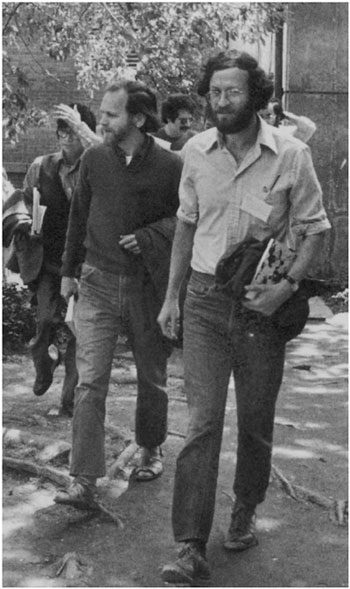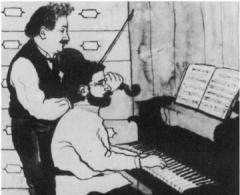
This Article From Issue
March-April 2009
Volume 97, Number 2
Page 152
DOI: 10.1511/2009.77.152
THE ART AND POLITICS OF SCIENCE. Harold Varmus. xiv + 315 pp. W. W. Norton, 2009. $24.95.
Harold Varmus’s new book, The Art and Politics of Science, is a timely memoir of a remarkable career. It hits the stores just as that career is taking a new turn: Varmus will be one of the foremost scientific advisers to the Obama administration.
In this memoir, Varmus traces the trajectory of his career, outlining events in roughly chronological order. He moves rapidly over his early life, touching on his childhood in New York City, his undergraduate years at Amherst, his graduate studies in English literature at Harvard and his training at Columbia University’s College of Physicians and Surgeons. Armed with a medical degree but drawn to science, he did research in the U.S. Public Health Service at the National Institutes of Health (NIH) as an alternative to military service during the Vietnam War (the “yellow beret” era, which was a golden age for NIH research).

From The Art and Politics of Science
Then in 1970 he took a scientific faculty position at the University of California at San Francisco, where researchers such as J. Michael Bishop and Herbert Boyer were doing groundbreaking research in molecular biology. Varmus entered into a long and conspicuously productive collaboration with Bishop, studying the molecular biology of cancer genes. The two men became famous and influential, primarily because they discovered cellular genes that could cause cancer when mutated and hijacked by RNA viruses. To those in the field, their laboratory was a formidable competitive force, filled with talented graduate students and postdocs attracted by hot science.
In 1984, though, Varmus and Bishop separated their laboratories at UCSF. They became closer friends even as their scientific paths diverged. In 1989 they received the Nobel Prize for Physiology or Medicine for their discovery of the cellular origin of retroviral oncogenes. But Varmus was still the second half of “Bishop and Varmus”; he remained in the shadow of his more senior collaborator until he left UCSF in 1993 to become NIH director.
Some of the most engaging stories in The Art and Politics of Science recount Varmus’s political travails as NIH director. On the cover of the book is a portrait (by Jon R. Friedman) of Varmus smiling; he is seated in front of Jacques-Louis David’s well-known painting of Marie and Antoine Lavoisier. The latter is, of course, one of the founders of modern chemistry, a man who also engaged in the politics of science, but with an unhappy ending: He was guillotined at the height of the French Revolution.
Varmus clearly still has his head about him. But his accounts of setting priorities for research, using science to set policy, handling scandals involving NIH scientists, and dealing with Congress do show that research politics can be a helmet sport. The NIH is drawn into political battles that its director must manage. But there are also political highs. Varmus was seated between Hillary Clinton and Tipper Gore at President Clinton’s 1998 State of the Union address, signaling to all the world the great esteem in which medical science was held at the highest reaches of government.
One of the striking characteristics of many NIH directors is how well they write (James Wyngaarden, Don Fredrickson and Bernadine Healy come to mind). They also recognize how important it is to address nonscientists—members of Congress and the general public—in language that’s easy to comprehend.
Varmus’s experience in Washington illustrates the importance of public communication. While he was NIH director, controversy over embryo research was unremitting. The cloning of Dolly the sheep at the Roslin Institute and the cultivation of human embryonic stem cells at Johns Hopkins and at the University of Wisconsin intensified an already fractious debate. At the appropriation hearings to fund the NIH that followed the birth of Dolly, Varmus gave an impromptu, unscripted talk about stem cells, cloning and cell biology to a rapt audience. It was plain to those in the room that he had a mastery of the details, a sense of why the science mattered and a compelling vision of where it might go. Word circulated quickly that the NIH was directed by someone who knew what he was talking about and cared about it enough to explain it to Congress. It turns out that Varmus had been coached in public speaking soon after taking the job, which points to his wisdom in knowing that it was an important skill to develop. He clearly recognized that history favors the prepared advocate.
In 1999, near the end of President Clinton’s second term, Varmus left the NIH to become the director of one of the largest, oldest and most prestigious cancer research centers, Memorial Sloan-Kettering Cancer Center in Manhattan. He says little about that job, which he still holds, but notes that he was relieved to get out of Washington.
Now, however, Varmus will be traveling to Washington frequently to co-chair the President’s Council of Advisors on Science and Technology with Harvard physicist John Holdren (who will be White House science adviser) and biologist Eric Lander of MIT and Harvard. Varmus’s co-chairmanship assures that he will continue to be an influential figure in American science. Judging from the contents of this book, that is a very good thing for the country.
The Art and Politics of Science ends with three chapters addressing the public-policy concerns into which Varmus has poured his energies: research on embryos, cloning and stem cells; global health and global science; and open-access publishing. These chapters, which can largely stand alone, concisely summarize the stakes in debates that will continue. Varmus reviews many salient events quickly, in language accessible to nonscientists. He fair-mindedly recounts most of the best arguments of his adversaries as well as his own views. This section of the book could be very useful in academic courses on science policy.
The new administration is expected to effect an about-face in national policy on stem-cell research. Many anticipate an opening of the federal-funds spigot for a research field that has been tightly constrained for several decades. Change may have already begun by the time this review is published.
The arguments in the chapter on global health show real passion. Varmus goes to great lengths to explain that health science has been undervalued as a tool for economic development and foreign policy. It is not just quixotic idealists who are interested in this approach; hardheaded realists across the political spectrum have begun to see the practical value of health research aimed at the problems of the global poor. Now that Hillary Clinton is Secretary of State, the warm relationship Varmus had with her when she was First Lady may turn out to matter, not least in policies affecting global health.
In the chapter on open-access publication, Varmus argues forcefully for “universal and unfettered delivery of knowledge.” He acknowledges the arguments and interests of the publishers and scientific societies that disagree with his views, but he stands his ground and makes it clear that the battles are not over.
Some readers will come to The Art and Politics of Science seeking insight into its author. But the book’s lasting value lies in what it has to offer those interested in learning about the career of someone who became famous through science and then turned to the political stewardship of biomedical research.
Varmus still smarts from having occasionally been beaten to a discovery that a different scientific approach might have snared for him. Apparently even a Nobel Prize is only partial recompense for lost opportunities. Aspiring scientists will see the importance of scientific competition in Varmus’s story. His obvious competitiveness is complemented by his clear affection for others in the field, though. And he keeps his rhetoric in check, giving credit where credit is due. The book would be more piquant if it settled some scores, but Varmus turns his analytical firepower on his own mistakes rather than on the offenses of others.
And there’s another lesson here for aspiring scientists: The path to a Nobel Prize and prestigious directorships may be highly nonlinear. Varmus did not hit his stride before age 30. He recalls digging out a C in organic chemistry at Amherst. Harvard Medical School rejected Varmus twice, and one of their interviewers recommended that he join the army to acquire some focus. (This will not go into the annals of sage advice, obviously, nor that compendious volume Great Ideas from Harvard.) Juicy stories of errant judgment reinforce this underlying message: Careers that appear from a distance to be a systematic climb up Mount Research may actually be fraught with detours and dead ends for those on the trek. And it’s nice to know you can get into medical school at Columbia with a C in orgo—not to mention getting to meet the king of Sweden in Stockholm.
It is interesting to compare Varmus’s memoir with that of Bishop, whose book How to Win the Nobel Prize came out in 2003. Their personalities and writing styles are quite distinct. Bishop, whose sentences tend to be syntactically complex, has a penchant both for history and for the well-turned one-liner. Varmus offers detail, accuracy, straightforward political analysis and a linear narrative. But their books have much in common. Both men recount the story of the work they did together at UCSF. Both are beautifully lucid writers with a reverence for science (although neither initially intended to become a scientist). And the central theme of both memoirs is that elegant, beautiful science can be extremely useful in addressing real-world problems. They share a belief in the social value of scientists engaging in the political process. As Bishop puts it,
to the extent that science requires public support, as it clearly does, politics is essential to science; and to the extent that science supports public welfare, as it clearly does, science is essential to politics.
Varmus and Bishop also both note the need to strike a delicate balance by cultivating the best in science without promising more than it can deliver, and by improving public health without letting bureaucrats and politicians oversteer research.
The Art and Politics of Science sketches a circuitous but amazing career. Let us hope that this is just the first of two volumes, to be followed by a book celebrating scientific achievements in the Obama era.
Robert Cook-Deegan is director of the Center for Genome Ethics, Law and Policy at the Institute for Genome Sciences and Policy, Duke University. He is the author of The Gene Wars: Science, Politics, and the Human Genome (W. W. Norton, 1994). A physician, he did postdoctoral research on the molecular biology of oncogenes before becoming a congressional science fellow in 1982.

American Scientist Comments and Discussion
To discuss our articles or comment on them, please share them and tag American Scientist on social media platforms. Here are links to our profiles on Twitter, Facebook, and LinkedIn.
If we re-share your post, we will moderate comments/discussion following our comments policy.